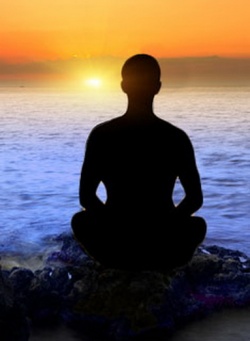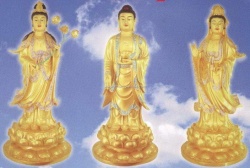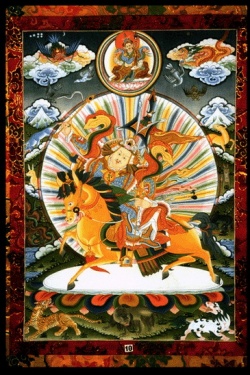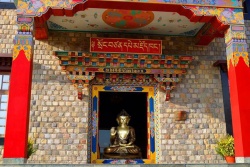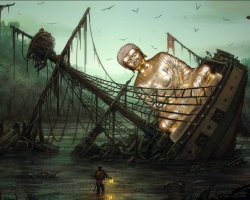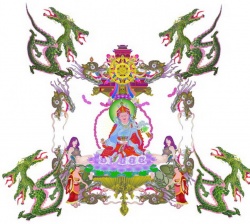Rebirth
Rebirth in Buddhism is the doctrine that the evolving consciousness (Pali: samvattanika-viññana) or stream of consciousness (Pali: viññana-sotam, Sanskrit: Vijñāna-srotām, Vijñāna-santāna, or Citta-santāna) upon death (or "the dissolution of the aggregates" (P. Khandhas, S. Skandhas)), becomes one of the contributing causes for the arising of a new aggregation. The consciousness in the new person is neither identical nor entirely different from that in the deceased but the two form a causal continuum or stream.
In traditional Buddhist cosmology these lives can be in any of a large number of states of being including the human, any kind of animal and several types of supernatural being (see Six realms). Rebirth is conditioned by the karmas (actions of body, speech and mind) of previous lives; good karmas will yield a happier rebirth, bad karmas will produce one which is more unhappy. The basic cause for this is the abiding of consciousness in ignorance (Pali: Avijja, Sanskrit: Avidya): when ignorance is uprooted, rebirth ceases. One of the analogies used to describe what happens then is that of a ray of light that never lands.
Buddhist terminology and doctrine
There is no word corresponding exactly to the English terms "rebirth", "metempsychosis", "transmigration" or "reincarnation" in the traditional Buddhist languages of Pāli and Sanskrit: the entire process of change from one life to the next is called punarbhava (Sanskrit) or punabbhava (Pāli), literally "becoming again", or more briefly Bhava, "becoming", while the state one is born into, the individual process of being born or coming into the world in any way, is referred to simply as "birth" (Jāti). The entire universal process that gives rise to this is called Saṃsāra.
Within one life and across multiple lives, the empirical, changing self not only objectively affects its surrounding external world, but also generates (consciously and unconsciously) its own subjective image of this world, which it then lives in as 'reality'. It lives in a world of its own making in various ways. It "tunes in" to a particular level of consciousness (by meditation or the rebirth it attains through its Karma) which has a particular range of objects - a world - available to it. It furthermore selectively notices from among such objects, and then processes what has been sensed to form a distorted interpretive model of reality: a model in which the 'I am' conceit is a crucial reference point. When Nibbana is experienced, though, all such models are transcended: the world stops 'in this fathom-long carcase'.
Historical context
The Buddha lived at a time of great philosophical creativity in India when many conceptions of the nature of life and death were proposed. Some were materialist, holding that there was no existence and that the self is annihilated upon death. Others believed in a form of cyclic existence, where a being is born, lives, dies and then is reborn, but in the context of a type of determinism or fatalism in which Karma played no role. Others were "eternalists", postulating an eternally existent self or soul comparable to that in [[Wikipedia:Christianity|Christianity]]: the ātman survives death and reincarnates as another living being, based on its karmic inheritance. This is the idea that has become dominant (with certain modifications) in modern Hinduism.
The Buddha's concept was distinct, consistent with the common notion of a sequence of lives over a very long time but constrained by two core concepts: that there is no irreducible self tying these lives together (anattā) and that all compounded things are subject to dissolution, including all the components of the human person and personality (anicca). The story of The Buddha's life presented in the early texts does not allude to the idea of rebirth prior to his Enlightenment, leading some to suggest that he discovered it for himself. The Buddha's detailed conception of the connections between action (Karma), rebirth and causality is set out in the twelve links of Dependent origination.
Ideas of rebirth
|
Supra-mundane stages, fetters and rebirths |
|||
|
stage's |
abandoned |
rebirth(s) |
|
|
1. identity view |
lower |
up to seven more times as |
|
|
once more as |
|||
|
4. sensual desire |
once more in |
||
|
6. material-rebirth lust |
higher |
none |
|
|
Source: Ñāṇamoli & Bodhi (2001), Middle-Length Discourses, pp. 41-43. |
|||
There are many references to rebirth in the early Buddhist scriptures. These are some of the more important; Mahakammavibhanga Sutta (Majjhima Nikaya 136); Upali Sutta (Majjhima Nikaya 56); Kukkuravatika Sutta (Majjhima Nikaya 57); Moliyasivaka Sutta (Samyutta Nikaya 36.21); Sankha Sutta (Samyutta Nikaya 42.8).
Some English-speaking Buddhists prefer the term "rebirth" or "re-becoming" (Sanskrit: punarbhava; Pali: punabbhava) to "reincarnation" as they take the latter to imply a fixed entity that is reborn. It is said to be the "evolving consciousness" (Pali: samvattanika viññana, M.1.256) or "stream of consciousness" (Pali: viññana sotam, D.3.105) that reincarnates. The early Buddhist texts make it clear that there is no permanent consciousness that moves from life to life. The lack of a fixed self does not mean lack of continuity. In the same way that a flame is transferred from one candle to another, there is a conditioned relationship between one life and the next: they are neither identical nor completely distinct.
While all Buddhist traditions seem to accept some notion of rebirth, there is no unified view about precisely how events unfold after the moment of death. The medieval Pali scholar Buddhaghosa labeled the consciousness that constitutes the condition for a new birth as described in the early texts "rebirth-linking consciousness" (patisandhi). Some schools conclude that Karma continued to exist and adhere to the person until it had worked out its consequences. For the Sautrantika school each act "perfumed" the individual and led to the planting of a "seed" that would later germinate as a good or bad karmic result. Theravada Buddhism generally asserts that rebirth is immediate while the Tibetan schools hold to the notion of a Bardo (intermediate state) that can last up to forty-nine days. This has led to the development of a unique 'science' of death and rebirth, a good deal of which is set down in what is popularly known as The Tibetan Book of the Dead.
Theravada Buddhism generally denies there is an intermediate state, though some early Buddhist texts seem to support it. There are zero teachings about this state found in the Agamas/Nikayas of the early schools, only vague references to said state that are open to interpretation. Among the thousands of suttas there is not a single one that gives any instruction on how one could influence one's rebirth in some kind of in between stage, just a handful of passages that could imply that there is some kind of interval between death and birth. There are some passages that imply one could reach Nibbana/Nirvana in this between state but as mentioned above there is zero instruction on how to do so. Therefore it's just as likely that the practices allowing one to reach Nibbana/Nirvana in this state are totally unrelated to the state itself and instead would simply be the end result of the standard practices laid out in the Agamas/Nikayas (as opposed to being the result of some kind of practice similar to the Tibetan Bardo practice). One school that adopted the view of possibly influencing ones rebirth while in the in between state was the Sarvastivada, who believed that between death and rebirth there is a sort of limbo in which beings do not yet reap the consequences of their previous actions but may still influence their rebirth. The death process and this intermediate state were believed to offer a uniquely favourable opportunity for spiritual awakening. There are zero teachings about this state found in the Agamas/Nikayas of the early schools. Only vague references to said state.
Rebirth as cycle of consciousness
Another view of rebirth describes the cycle of death and birth in the context of consciousness rather than the birth and death of the body. In this view, remaining impure aggregates, Skandhas, reform consciousness.
Buddhist meditation teachers suggest that observation reveals consciousness as a sequence of conscious moments rather than a continuum of awareness. Each moment is an experience of an individual mind-state such as a thought, a memory, a feeling or a perception. A mind-state arises, exists and, being impermanent, ceases, following which the next mind-state arises. Thus the consciousness of a sentient being can be seen as a continuous series of birth and death of these mind-states. Rebirth is the persistence of this process.
In the practice of Vipassana meditation, the meditator uses "bare attention" to observe the endless round of mind-states without interfering, owning or judging. This limits the Power of desire which, according to the second noble truth of Buddhism, is the cause of Suffering (Pali: Dukkha; Sanskrit: duḥkha) and leads to Enlightenment (Pali: Nibbana; Sanskrit: Nirvana).
Rebirth (punàbhinibbatti or punabbhava) is idea that at death the mind re-establishes itself in a newly fertilized egg, thus animating a new body and continuing the individual. The Buddha taught that the force propelling the mind into a new body is craving (tanhà), specifically the craving for pleasure, for identity and the craving to live.
The ultimate purpose of all Buddhist practice and training is to eliminate craving and thus stop the process of rebirth. The Buddhist doctrine of rebirth differs from the Hindu teaching of reincarnation in two significant ways. According to Hinduism,
(1) an eternal self or soul (àtman) passes from one body to another and (2) eventually merges with the World Soul (Brahman).
(1) nothing is eternal, that the individual is a flowing, constantly changing process and (2) that liberation or Nibbana is the ceasing of this process.
People often ask, "If there is rebirth, why don't I remember my past lives?" Most of us cannot remember anything that happened to us before the age of 2 to 5, so how could we remember something several years or decades before that? Also, human birth is very rare:
"Monks, suppose that this great earth were totally covered with water, and a man were to toss a yoke with a single hole there. A wind from the east would push it west, a wind from the west would push it east. A wind from the north would push it south, a wind from the south would push it north. And suppose a blind sea-turtle were there. It would come to the surface once every one hundred years. Now what do you think: would that blind sea-turtle, coming to the surface once every one hundred years, stick his neck into the yoke with a single hole?"
"It would be a sheer coincidence, lord, that the blind sea-turtle, coming to the surface once every one hundred years, would stick his neck into the yoke with a single hole."
"It's likewise a sheer coincidence that one obtains the human state. " Samyutta Nikaya 56.48
The blind sea turtle is a good simile showing how hard it is to obtain human rebirth. A goldfish only has a memory of about 3 seconds. Most other animals don't have that long of a memory either (except for elephants). If we have done all / most of our past lives as animals, we cannot expect to remember them much or at all.
Rebirth in the Suttas
The suttas (discourses) are permeated throughout with discussion of rebirth and what leads to the end of rebirth.
"He recalls to mind his various temporary states in days gone by; one birth, or two or three or four or five births, 10 or 20, 30 or 50, a 100 or a 1,000 or a 100,000 births, through many cycles of cosmic contraction and cosmic expansion . . .
The recollects his numerous past lives: that is, (he recollects) one birth, two, three, four, or five births; ten, twenty, thirty, forty, or fifty births; a hundred, a thousand, or a hundred thousand births; many hundreds of births, many thousands of births, many hundreds of thousands of births. (He recalls:) 'Then I had such a name, belonged to such a clan, had such an appearance; such was my food, such my experience of pleasure and pain, such my span of life. Passing away thence, I re-arose there. There too I had such a name, belonged to such a clan, had such an appearance; such was my food, such my experience of pleasure and pain, such my span of life. Passing away thence, I re-arose here.' Thus he recollects his numerous past lives in their modes and their details."
Source
One question that is often asked is, "What happens to us after death?" According to the Buddhists, rebirth takes place at the end of this life. Buddhists regard rebirth as a fact. There is evidence that each person has lived many lives in the past and will continue to lives more in the future.
The Case for Rebirth
Rebirth is a reality although one may not be aware of it. The existence of past lives has been confirmed by those who have developed their minds through meditation. Meditators who has attained powers of concentration have been able to recall their previous lives in great detail. The Buddha and His prominent disciples in many countries and at different times have been able to prove the existence of past lives. The Buddha, on the night of His Enlightenment, developed the ability to see His past lives. He also saw beings dying in one state of existence and being reborn in another, according to their actions. Thus it was from personal experience that the Buddha taught His followers the truth of rebirth.
In recent years, evidence has been collected and documented, which confirm that rebirth is a fact. There have been cases of people who have been able to recollect their experience of previous lives. Their description of places and persons of the past were confirmed after thorough investigations.
The best known example of this is the case of Bridey Murphy. Mrs. Ruth Simmons of the United States recollected a previous life in Ireland, more than 100 years ago. She said she has been Bridey Murphy in the year 1789 and gave full details of Bridey’s life. The details were later checked and found to be quite accurate although in the present life, Mrs. Simmons had never been outside America.
In another case in England, a woman called Mrs. Naomi Henry recollected two previous lives. In the first instance, she recalled her life as an Irishwoman living in a village called Greehalgh in the seventeenth century. Research into her case was carried out and this revealed that such a village did exist then. In the second instance, she remembered that in one of her previous lives, she was a Englishwoman who became a nurse to several children in an English town called Downham in 1902. A search into the official records kept in Downham proved that such a woman did exist.
Professor Ian Stevenson of the University of Virginia, USA, has researched and published his finding on over twenty cases of rebirth. These cases, which have been well documented and verified, are form various countries including France, Italy, India, Sri Lanka and Burma.
Rebirth in the Six Realms
Buddhism teaches that birth, death and rebirth are part of the continuing process of change. This is similar to the continuous process of growth, decay and replacement of cells in one’s body. According to medical expert, after every seven years, all the cells in one’s body are replaced by new ones.
At the moment of death, when this life is over, and the body can no longer survive, the mind is separated from the body. At that time, the craving for lives causes one to seek a new existence, and the karma done previously determine the place of one’s rebirth.
There are six realms in which one may be reborn after death. They are the realms of gods (deva), the demigods (Asura), human beings, animals, hungry ghosts and the hells. These are just general categories and within each, there exist many sub-categories. The six realms of existence include three relatively happy states, and three relatively miserable states. The realms of the gods, the demigods and human beings are considered more happiness and less suffering. The realms of animals, hungry ghosts and the hells are considered relatively miserable because living beings there suffer more from fear, hunger, thirst, heat ,cold and pain.
In general, wholesome actions like good conduct, charity and mental development, are the cause of rebirth in the happy realms of gods, demigods and human beings. On the other hand, unwholesome actions like immoral conduct, miserliness and cruelty cause rebirth in the unhappy realms of animals, hungry ghosts and the hells.
One need not wait until one is reborn to imagine what existence in other realms is like. For instance, when one is intensely happy or totally at peace with oneself, one experience a state similar to that of the gods. When one follows one baser instincts and is totally preoccupied with eating, sleeping and sex, one’s existence is like that of the animals. Then again, when one is overwhelmed by fear and pain, or is tortured and killed in this life, one experience suffering like that of the hells.
Of all the six realms, the realm of human beings is considered the most desirable. In the realm of human beings, the conditions for attaining Nirvana are better. In general, in the unhappy realms, the suffering of living beings is so intense and their ignorance so great that they are unable to recognise the Truth and follow the path to attain freedom. Alternatively, living beings in the realms of the gods and demigods experience so much happiness and have so many distractions that they do no think of rebirth until is too late. Then they may be reborn in one of the lower realms of suffering. In the realm of human beings, however, people experience both happiness and suffering, and are intelligent enough to recognise the Truth and follow the path to attain freedom from the cycle of birth and death. Therefore, one is indeed fortunate to be born as a human being, and should remember that the principal cause of birth in this realm is Good Conduct.
The Cycle of Birth and Death
The Buddha pointed out that whenever one is reborn, whether as a human beings, as an animal, or as a god, non of these states of existence is permanent. The average life span of the living beings in the six realms of existence differ but none of them lasts forever. Eventually, rebirth will take place. The realm into which one is reborn and one’s conditions of rebirth are determined by one’s past and present actions. This is the law of karma at work.
Because of the force of their karma, people are born and reborn endlessly, in one realm of existence or in another. The Buddha declared that there is no permanent rest in this cycle of birth and death. It is only when one follows the Noble Eightfold path taught by the Buddha and eventually attains Nirvana, that one finally becomes free from this ceaseless cycle and gains supreme and permanent happiness.
People who understand karma and rebirth see life in a better perspective. They understand that every action they perform will have its effects now and in the future. The knowledge gives them hope and strength in the face of difficulties. It gives them courage to continue doing good. They are convinced that they will experience the good effects of their wholesome actions either in the short-term or in the long-term.
